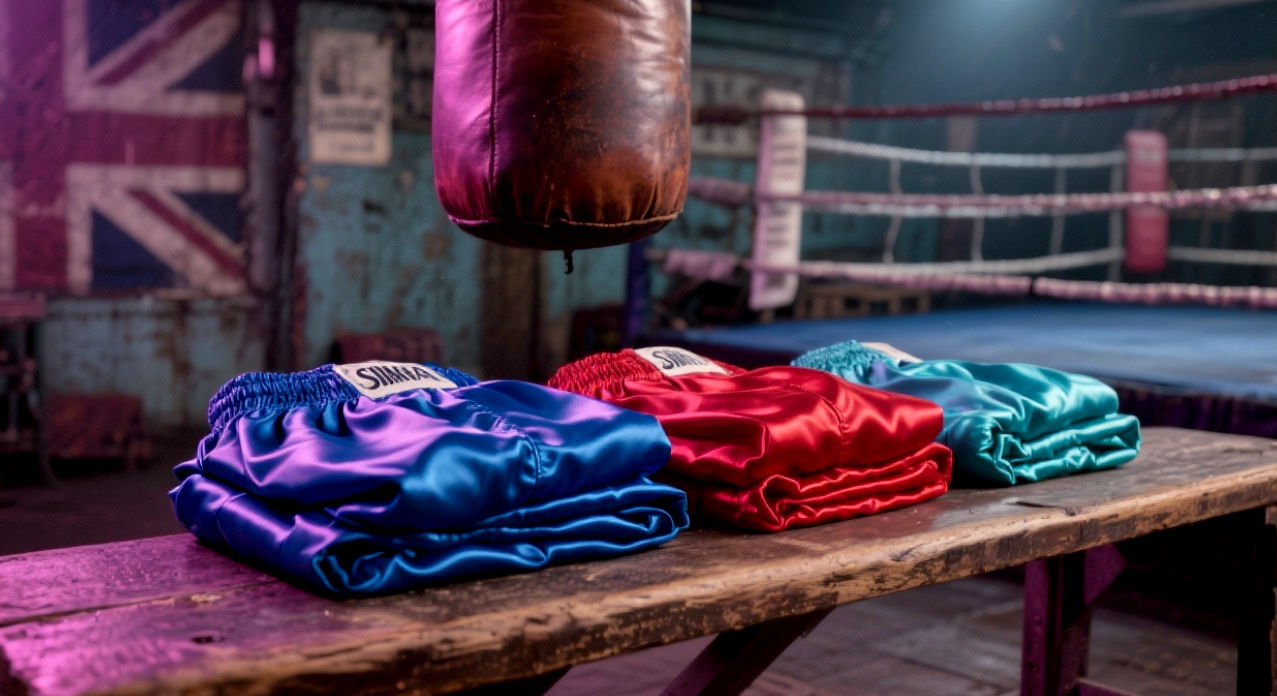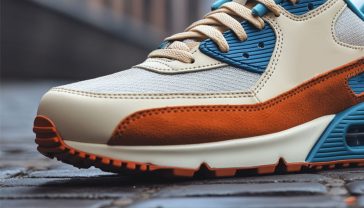The Complete Guide to Finding the Best Boxing Shorts: A British Boxer’s Bible
Your definitive guide to choosing the perfect boxing shorts. We break down everything from satin vs. polyester to sizing, top UK brands, and custom designs.

This post may contain affiliate links. If you make a purchase through these links, we may earn a commission at no additional cost to you.
Step into any boxing gym in Britain, from a spit-and-sawdust club in Bethnal Green to a slick new facility in Manchester, and you’ll see a flash of colour and style. Beyond the head guards and gloves, a fighter’s shorts are their uniform, their flag, and a crucial piece of kit. But finding the right pair isn’t just about picking your favourite colour. The best boxing shorts are a blend of history, science, and personal expression. They can affect how you move, how you feel, and even how your opponent sees you.
Choosing the right shorts can feel daunting. You’re faced with a world of different materials, strange cuts, and brands you’ve never heard of. It’s tempting to just grab the cheapest pair or the ones that look coolest. But that’s a rookie mistake. The wrong shorts can chafe, ride up, restrict your footwork, or hold sweat like a sponge, weighing you down when you need to be light on your feet.
This guide is here to cut through the noise. We’re going to break down everything you need to know to find the perfect pair of boxing shorts, whether you’re training for your first amateur bout or you’re a seasoned pro looking for an edge. Think of this as your ringside coach, giving you the inside knowledge to make a choice that boosts your comfort, your confidence, and your performance.
It’s More Than Just Fabric: Why Your Boxing Shorts Are Your Secret Weapon
First things first, let’s get one thing straight: boxing shorts are not just fancy PE shorts. They are a specialised piece of equipment, designed from the ground up for the unique demands of the sweet science.
Imagine you’re in the ring. You need to be explosive. You need to pivot on a sixpence, dart in and out of range, and shift your weight in a split second. Your clothing has to work with you, not against you. That’s where purpose-built boxing shorts come in.
- Freedom of Movement: The entire design is about letting your legs move freely. A wider cut around the legs and special slits on the side mean you can take a wide stance, lunge, or pivot without your shorts pulling tight and holding you back.
- Lightweight Design: Boxing is exhausting. The last thing you need is extra weight from your kit. Shorts are made from feather-light materials that won’t drag you down, especially in the later rounds when every ounce of energy counts.
- Comfort and Psychology: When you look the part, you feel the part. Pulling on a proper pair of boxing shorts is part of a ritual. It helps you get into the mindset of a fighter. Plus, a comfortable, well-fitting pair means you’re not distracted by annoying chafing or a waistband that keeps slipping. You can focus purely on the fight.
So, while they might seem like a simple bit of clothing, your shorts are a fundamental part of your boxing arsenal.
The Anatomy of a Champion’s Trunks: What Are You Actually Wearing?
To choose the best pair, you first need to understand what makes them tick. Let’s break down the key parts of a standard pair of boxing shorts.
The All-Important Waistband
This is arguably the most important feature. A traditional boxing short has a wide, elasticated waistband, usually about four inches thick. There’s a good reason for this. In both amateur and professional boxing, the waistband marks the legal target area. Punches below the belt are illegal, and this wide band gives the referee a clear line to judge what’s a fair body shot and what’s a low blow.
Beyond the rules, it also provides excellent support around your core and hips. It’s designed to sit high on your waist to keep the shorts securely in place, no matter how much you move. It also helps to hold your protective groin guard (or “box”) securely.
The Cut and Length
Boxing shorts have a distinct cut. They are much baggier and longer than running shorts or shorts for other sports. Traditionally, they come down to just above the knee. This loose fit is all about unrestricted movement. It ensures the fabric never clings to your legs or thighs, allowing you to perform deep squats, lunges, and agile footwork with ease. You’ll never feel the material pull or resist, which is vital for explosive power.
The Crucial Leg Slits
Look closely at the side of a pair of boxing shorts and you’ll notice a small cut, or slit, at the bottom of each leg seam. This tiny detail makes a huge difference. These leg slits give the fabric extra room to move, further enhancing your range of motion. When you take a wide stance or lunge forward to throw a punch, these slits open up to prevent the material from tightening around your thigh. It’s a simple but brilliant piece of design that’s all about performance.
Picking Your Armour: A Deep Dive into Materials
The fabric of your shorts has a huge impact on their feel, performance, and durability. There are a few main players in the world of boxing shorts, each with its own pros and cons.
Classic Satin: The Ring-Ready Sheen
Satin is the original, the classic, the fabric you picture when you think of boxing legends like Muhammad Ali. It’s a type of polyester weave that’s incredibly smooth, lightweight, and has a distinctive glossy sheen that looks fantastic under the bright lights of the ring.
- Pros: It’s super lightweight and feels incredibly smooth against the skin. It doesn’t cling, and the way it reflects light gives it a professional, high-quality look that’s perfect for competition.
- Cons: It isn’t the best at wicking sweat away from your body. It can also be a bit more delicate than other materials, so it needs careful washing to avoid snagging.
Modern Polyester: The Workhorse Fabric
This is the most common material for modern boxing shorts, especially for training. It’s a durable, no-nonsense synthetic fabric that’s built to last through countless gym sessions.
- Pros: It’s tough, long-lasting, and relatively cheap. Many modern polyester shorts come with moisture-wicking technology (often branded as things like “Dri-Fit”), which actively pulls sweat away from your skin to keep you cool and dry. It’s also easy to wash and dries quickly.
- Cons: It doesn’t have the same premium look or feel as satin. Cheaper versions can sometimes feel a bit rough or stiff.
Nylon and Microfiber Blends: Lightweight Performance
Many high-end shorts now use advanced microfiber fabrics or nylon blends. These are engineered materials designed for maximum performance. Think of them as the high-tech option.
- Pros: They are exceptionally lightweight and often have a bit of stretch, offering incredible freedom of movement. They are also brilliant at moisture-wicking and are very breathable, making them perfect for intense, sweaty workouts.
- Cons: These advanced fabrics often come with a higher price tag. They can also be less durable than a thick, heavy-duty polyester if not cared for properly.
Our Verdict? For competition and looking your absolute best, satin is the champion. For everyday training and durability, a good quality moisture-wicking polyester is your most reliable sparring partner.
Getting the Fit Right: How Your Shorts Should Feel
A perfect fit is non-negotiable. Ill-fitting shorts are not just uncomfortable; they’re a liability. Here’s how to make sure you get it spot on.
Finding Your Size: Don’t Guess!
Boxing short sizing can be a bit different from your regular trousers. Most brands use waist measurements in inches (e.g., 30″, 32″, 34″) or general sizes (S, M, L, XL).
Never assume your size. Always check the brand’s specific size chart before you buy. If you can, measure your waist with a tape measure. Measure around your natural waistline, which is usually just above your belly button. This is where the shorts are designed to sit.
When you try them on, they should feel secure at the waist but not tight. You should have plenty of room around the hips and thighs. If they feel restrictive when you do a deep squat or lift your knee high, they are too small.
Waistband Wisdom: Secure but Not Suffocating
The waistband should sit comfortably on your natural waist without digging in. Most shorts have both strong elastic and a drawstring, so you can get the fit just right. It needs to be tight enough that it won’t slip down during training, but not so tight that it restricts your breathing or becomes uncomfortable. Remember, you’ll have a groin guard under there too, so make sure there’s enough room for it.
Length Matters: Traditional vs. Modern Cuts
The length of boxing shorts is partly a matter of personal style.
- Traditional Cut: This is the classic look, with the hem falling just above the kneecap. It offers maximum coverage and a timeless, professional appearance.
- Modern Cut: Some modern brands offer slightly shorter cuts, which finish mid-thigh. Some fighters prefer this as they feel it’s even less restrictive and offers a more athletic look.
There’s no right or wrong answer here. It’s about what you feel most comfortable and confident in. However, for amateur competitions in the UK, it’s always wise to stick to a more traditional, knee-length style to be safe.
A Tale of Two Trunks: Boxing Shorts vs. Muay Thai Shorts
It’s a common mistake for beginners to mix these two up, but they are very different beasts, designed for very different sports.
Boxing Shorts are long, baggy, and have a high waist. They are built for the footwork, pivoting, and in-and-out movement of boxing.
Muay Thai Shorts, on the other hand, are very short, with a much wider, more flexible cut on the legs. This is because Muay Thai (or Thai Boxing) involves a huge amount of kicking. The short, slit design is essential to allow fighters to throw high kicks to the head without any restriction.
Wearing Muay Thai shorts for boxing is fine for training, but they don’t offer the same professional look or high waistband. Wearing boxing shorts for Muay Thai is a terrible idea—you’ll find your kicks are immediately restricted by the length and cut. Stick to the right tool for the job.
Rules of the Ring: Amateur vs. Professional Boxing Shorts in the UK
If you plan to compete, your shorts need to follow the rules. In the UK, amateur boxing is governed by England Boxing (and its Welsh and Scottish equivalents).
The main rule for amateur boxing is about colour. You will be assigned either the red corner or the blue corner. You are required to wear shorts (and a vest) that are predominantly that colour. This helps the judges and referee easily tell the two fighters apart. Your waistband must be a contrasting colour to clearly show the legal target area.
In professional boxing, the rules are much more relaxed. Fighters can wear almost any design or colour they like, which is why you see elaborate, custom-made shorts with tassels, flashy materials, and sponsorship logos.
If you’re just starting out and plan to compete as an amateur, it’s a good idea to get a simple pair of red shorts and a simple pair of blue shorts early on.
Your Ultimate Checklist: Top 7 Features to Look For
When you’re ready to buy, keep these key points in mind.
- Material: Is it lightweight and durable? If you sweat a lot, is it moisture-wicking?
- Waistband: Is it wide (around 4 inches), strong, and comfortable? Does it have a drawstring for an adjustable fit?
- Cut & Length: Is it baggy enough for total freedom of movement? Does the length suit your personal style and competition rules?
- Leg Slits: Does it have them? This small detail is a sign of a well-designed pair of shorts.
- Stitching: Check the quality of the stitching. It should be strong and secure, especially around the waistband and seams. Double-stitching is a good sign.
- Weight: The lighter the better. Good shorts should feel almost weightless.
- Brand Reputation: Stick with established boxing brands. They understand the specific needs of fighters and produce reliable, high-quality gear.
Keeping Your Kit in Fighting Shape: How to Care for Your Shorts
You’ve invested in a great pair of shorts, so you want them to last. Most boxing shorts, especially satin ones, need a little bit of care.
- Wash After Every Use: Don’t leave sweaty shorts festering in your gym bag. This is bad for the fabric and, frankly, unhygienic.
- Wash on a Cool, Gentle Cycle: Hot water can damage the elastic in the waistband and fade the colours. Use a cool wash (30°C) on a delicate setting.
- Turn Them Inside Out: This helps protect the outer surface, especially if it’s shiny satin or has logos on it.
- Don’t Use Fabric Softener: It can clog the pores of moisture-wicking fabrics, making them less effective.
- Air Dry Only: Never, ever put boxing shorts in the tumble dryer. The high heat will destroy the elastic and can shrink or damage the fabric. Hang them up to air dry. They’re so lightweight, they’ll be dry in no time.
The Best Boxing Shorts Brands for British Fighters
The UK has a rich boxing heritage, and there are some fantastic brands available, from global giants to local specialists.
The Classics: Lonsdale, Everlast, and Adidas
These are the names everyone knows.
- Lonsdale: A legendary British brand, deeply woven into the history of UK boxing. Lonsdale offers reliable, no-frills shorts that are perfect for beginners and amateurs. They are durable and widely available.
- Everlast: The American giant is a staple in gyms worldwide. They offer a huge range of shorts, from basic training models to high-end competition wear.
- Adidas: Known for their quality sportswear, Adidas boxing shorts are well-made, stylish, and often feature their performance-enhancing fabrics.
The Contenders: Ringside and Fly
These brands are aimed at more serious boxers.
- Ringside: Another huge name in the boxing world, Ringside makes excellent quality gear. Their shorts are known for being tough, durable, and well-designed for serious training.
- Fly: A premium British brand, Fly is known for its stylish, high-performance equipment. Their shorts are exceptionally well-made with top-quality materials, and are a popular choice for pro fighters.
The Artisans: Suzi Wong and Custom Kits
For something truly special.
- Suzi Wong: A UK-based family business that has become world-famous for creating spectacular custom boxing shorts. They have made kits for champions like Tyson Fury, Anthony Joshua, and Kell Brook. If you want a one-of-a-kind design, they are the gold standard.
Making Them Your Own: The World of Custom Boxing Shorts
As you progress in the sport, you might want a pair of shorts that reflect your personality or your boxing nickname. Custom shorts allow you to choose the fabric, colours, style, and add your name or logos.
It’s the ultimate way to express yourself in the ring and can give you a huge confidence boost. While they are more expensive, having a pair of shorts made just for you is a special experience. UK companies like Suzi Wong specialise in this, offering a full design service to bring your ideas to life.
7 Common Mistakes to Avoid When Buying Boxing Shorts
- Choosing Style Over Substance: Those super-flashy shorts might look great, but if they’re made from cheap material with poor stitching, they won’t perform or last. Function first.
- Getting the Wrong Size: Don’t guess. Measure your waist and check the size chart. Too tight restricts movement; too loose and they’ll be falling down.
- Buying the Wrong Type: Don’t buy Muay Thai shorts for boxing by mistake.
- Ignoring the Material: Thinking all fabrics are the same. Choose satin for looks, polyester for durability, and microfiber for high-tech performance.
- Forgetting About Competition Rules: If you’re going to compete as an amateur, you’ll need red and blue shorts. Don’t wait until the week before your first fight to realise this.
- Washing Them Incorrectly: Tumble-drying your shorts is a fast way to ruin them.
- Spending Too Much (or Too Little): You don’t need a £150 custom pair for your first day at the gym. Equally, the cheapest £10 pair online will likely fall apart quickly. Find a happy medium from a reputable brand.
Final Bell: Choosing the Shorts That Are Right for You
Your boxing shorts are more than just a piece of clothing. They are a tool designed to help you perform at your best. They carry the history of the sport in their cut and the science of performance in their fabric.
By understanding the key elements—the wide waistband, the baggy cut, the lightweight material, and the crucial leg slits—you are now armed with the knowledge to make an informed choice.
Start with a solid, reliable pair from a reputable brand. Focus on getting the fit perfect and choosing a material that suits your training needs. As you fall in love with the sport, you can explore different styles and even design your own custom pair.
Now, you know what to look for. Go find the shorts that make you feel like a champion. The rest is up to you.
Further Reading & Resources
To deepen your knowledge and stay connected with the British boxing scene, here are some highly respected websites and resources:
- England Boxing: The official website for the amateur boxing governing body in England. An essential resource for rules, club finders, and competition information.
- British Boxing Board of Control (BBBofC): The governing body for professional boxing in the UK. A good place to understand the professional side of the sport.
- Boxing News Online: Established in 1909, this is one of the world’s most authoritative sources for boxing news, interviews, and historical articles.
- BBC Sport Boxing: For reliable news, fight schedules, and high-quality journalism on both the British and world boxing scenes.
- Suzi Wong Custom Fightwear: Explore the world of custom designs and see what the pros wear on fight night.






